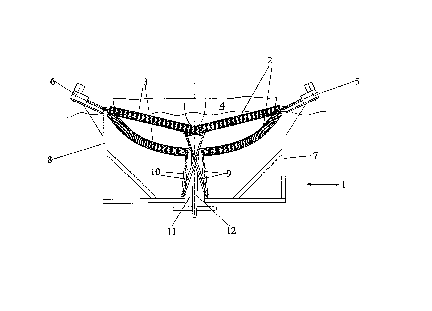Une partie des informations de ce site Web a été fournie par des sources externes. Le gouvernement du Canada n'assume aucune responsabilité concernant la précision, l'actualité ou la fiabilité des informations fournies par les sources externes. Les utilisateurs qui désirent employer cette information devraient consulter directement la source des informations. Le contenu fourni par les sources externes n'est pas assujetti aux exigences sur les langues officielles, la protection des renseignements personnels et l'accessibilité.
L'apparition de différences dans le texte et l'image des Revendications et de l'Abrégé dépend du moment auquel le document est publié. Les textes des Revendications et de l'Abrégé sont affichés :
| (12) Demande de brevet: | (11) CA 2252541 |
|---|---|
| (54) Titre français: | DISPOSITIF POUR LE NETTOYAGE EXTERIEUR DE COQUES DE BATEAUX |
| (54) Titre anglais: | DEVICE FOR EXTERNAL CLEANING OF SHIPS' HULLS |
| Statut: | Réputée abandonnée et au-delà du délai pour le rétablissement - en attente de la réponse à l’avis de communication rejetée |
| (51) Classification internationale des brevets (CIB): |
|
|---|---|
| (72) Inventeurs : |
|
| (73) Titulaires : |
|
| (71) Demandeurs : |
|
| (74) Agent: | SMART & BIGGAR LP |
| (74) Co-agent: | |
| (45) Délivré: | |
| (86) Date de dépôt PCT: | 1997-04-25 |
| (87) Mise à la disponibilité du public: | 1997-11-06 |
| Requête d'examen: | 1998-10-22 |
| Licence disponible: | S.O. |
| Cédé au domaine public: | S.O. |
| (25) Langue des documents déposés: | Anglais |
| Traité de coopération en matière de brevets (PCT): | Oui |
|---|---|
| (86) Numéro de la demande PCT: | PCT/DE1997/000834 |
| (87) Numéro de publication internationale PCT: | DE1997000834 |
| (85) Entrée nationale: | 1998-10-22 |
| (30) Données de priorité de la demande: | ||||||
|---|---|---|---|---|---|---|
|
L'invention vise à éviter le nettoyage manuel, coûteux et long, de coques de bateaux (4) et a pour objet une installation de nettoyage comprenant au moins un rouleau nettoyeur (2, 3) pouvant être entraîné en rotation, monté rotatif sur un châssis métallique (1), le/ou les corps du/ou des rouleaux se trouvant au moins partiellement au-dessous de la surface de l'eau.
The invention relates to a cleaning system to avoid time-consuming and
expensive manual cleaning of ships'hulls (4). Said system comprises at least
one cleaning roller (2, 3) which can be driven to rotate and is rotatably
mounted in a rack (1). The roller structures of said cleaning rollers are at
least partially positioned below the water surface.
Note : Les revendications sont présentées dans la langue officielle dans laquelle elles ont été soumises.
Note : Les descriptions sont présentées dans la langue officielle dans laquelle elles ont été soumises.

2024-08-01 : Dans le cadre de la transition vers les Brevets de nouvelle génération (BNG), la base de données sur les brevets canadiens (BDBC) contient désormais un Historique d'événement plus détaillé, qui reproduit le Journal des événements de notre nouvelle solution interne.
Veuillez noter que les événements débutant par « Inactive : » se réfèrent à des événements qui ne sont plus utilisés dans notre nouvelle solution interne.
Pour une meilleure compréhension de l'état de la demande ou brevet qui figure sur cette page, la rubrique Mise en garde , et les descriptions de Brevet , Historique d'événement , Taxes périodiques et Historique des paiements devraient être consultées.
| Description | Date |
|---|---|
| Le délai pour l'annulation est expiré | 2004-04-26 |
| Demande non rétablie avant l'échéance | 2004-04-26 |
| Réputée abandonnée - omission de répondre à un avis sur les taxes pour le maintien en état | 2003-04-25 |
| Lettre envoyée | 2001-04-24 |
| Exigences de rétablissement - réputé conforme pour tous les motifs d'abandon | 2001-04-11 |
| Réputée abandonnée - omission de répondre à un avis sur les taxes pour le maintien en état | 2000-04-25 |
| Symbole de classement modifié | 1998-12-29 |
| Inactive : CIB attribuée | 1998-12-29 |
| Inactive : CIB en 1re position | 1998-12-29 |
| Symbole de classement modifié | 1998-12-29 |
| Inactive : Acc. récept. de l'entrée phase nat. - RE | 1998-12-14 |
| Demande reçue - PCT | 1998-12-11 |
| Exigences pour une requête d'examen - jugée conforme | 1998-10-22 |
| Toutes les exigences pour l'examen - jugée conforme | 1998-10-22 |
| Demande publiée (accessible au public) | 1997-11-06 |
| Date d'abandonnement | Raison | Date de rétablissement |
|---|---|---|
| 2003-04-25 | ||
| 2000-04-25 |
Le dernier paiement a été reçu le 2002-03-26
Avis : Si le paiement en totalité n'a pas été reçu au plus tard à la date indiquée, une taxe supplémentaire peut être imposée, soit une des taxes suivantes :
Les taxes sur les brevets sont ajustées au 1er janvier de chaque année. Les montants ci-dessus sont les montants actuels s'ils sont reçus au plus tard le 31 décembre de l'année en cours.
Veuillez vous référer à la page web des
taxes sur les brevets
de l'OPIC pour voir tous les montants actuels des taxes.
| Type de taxes | Anniversaire | Échéance | Date payée |
|---|---|---|---|
| Taxe nationale de base - petite | 1998-10-22 | ||
| Requête d'examen - petite | 1998-10-22 | ||
| TM (demande, 2e anniv.) - petite | 02 | 1999-04-26 | 1999-04-08 |
| Rétablissement | 2001-04-11 | ||
| TM (demande, 3e anniv.) - petite | 03 | 2000-04-25 | 2001-04-11 |
| TM (demande, 4e anniv.) - petite | 04 | 2001-04-25 | 2001-04-25 |
| TM (demande, 5e anniv.) - petite | 05 | 2002-04-25 | 2002-03-26 |
Les titulaires actuels et antérieures au dossier sont affichés en ordre alphabétique.
| Titulaires actuels au dossier |
|---|
| MANFRED WEBER |
| Titulaires antérieures au dossier |
|---|
| S.O. |